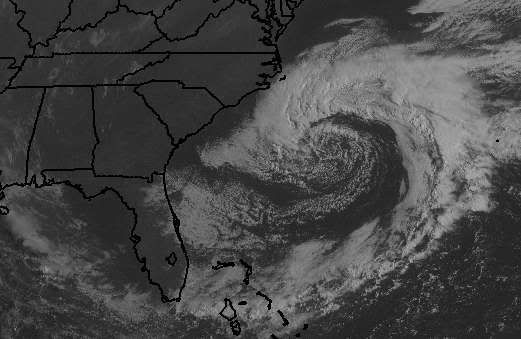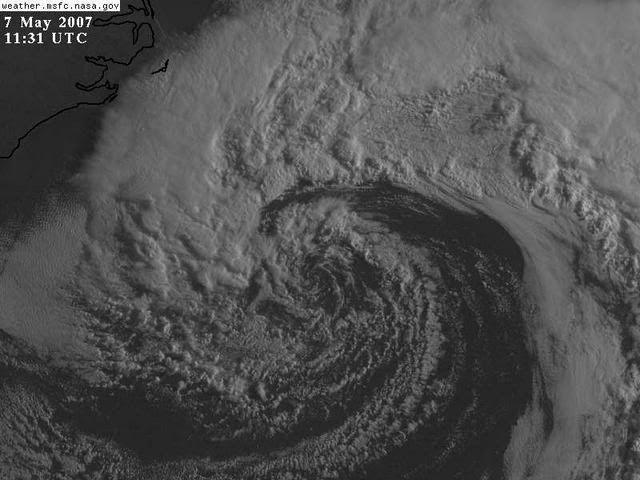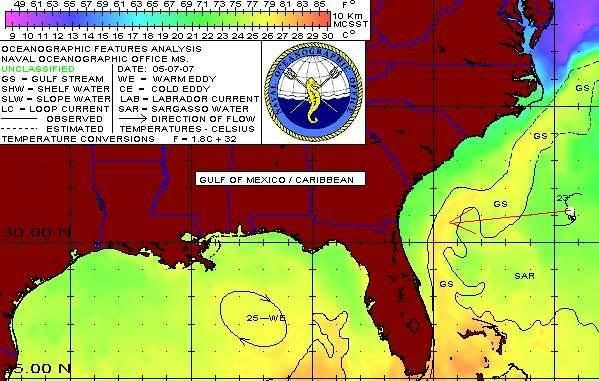2007 Atlantic Hurricane Season Outlook
It's too soon to find many clues about what the upcoming hurricane season might be like, since we are facing the famed "April Predictability Barrier". The atmosphere is not predictable enough to make a skillful forecast of seasonal hurricane activity in April (this changes by late May, when skillful predictions of the upcoming hurricane season CAN be made). Thus, we should put little faith in the predictions by the Klotzback/Gray group and TSR made in April, calling for 17 named storms, 9 hurricanes, and 4 or 5 intense hurricanes. However, there are a few indicators we can start looking at. I covered these in a talk I gave last week at Eckerd College in St. Petersburg that many of you asked to hear about, so here goes!
Figure 1. Sea Surface Temperature (SST) difference between March 2007 and 2005. Cool colors are regions where the SST was colder in 2007, and yellows and greens where SSTs were warmer in 2007. Image credit: NOAA/ESRL.
Sea Surface Temperature (SST) Outlook
Sea Surface temperatures are at the heart of any attempt to analyze seasonal hurricane activity, since SSTs change slowly and have a major impact on both the number of storms that form and their intensity. For example, the record-breaking Hurricane Season of 2005 had the warmest SSTs ever observed in the tropical Atlantic. Comparing the SSTs in March of 2007 with March of 2005 (Figure 1), we see that SSTs were more than 1 degree C cooler in 2007 over a large portion of the Atlantic west of the Lesser Antilles Islands. This is a key portion of the "Main Development Region" (MDR) for hurricanes (red box in Figure 1). The MDR is where 85% of all major hurricane form. Note, though, that the regions where Katrina, Rita, and Wilma formed--the Bahamas to the Western Caribbean--have SSTs warmer this year than in 2005. Overall, SSTs are well above average across most of the tropical Atlantic this year, continuing the pattern we have seen since 1995, when the current active Atlantic hurricane period began. We can expect this year's SSTs to support a more active than usual hurricane season, although there is still time for a significant cooling to occur if we get a major increase in the speed of the trade winds over the next few months.

Figure 2. Sea Surface Temperature (SST) departure from average in the region 120°W-170°W, 5°S-5°N (called the Niño 3.4 region) for 2006 and 2007. Temperatures +0.5ºC above average in this region indicate an El Niño episode; temperatures -0.5ºC below average indicate an La Niña. Note that EL Niño peaked in December, then rapidly decayed to neutral conditions in early February. Image credit:NOAA Climate Prediction Center.
El Niño/La Niña Outlook
Obviously, SSTs don't tell the whole story, since the second highest SSTs in the tropical Atlantic since the 1870s occurred last year. To our great relief, we had a very normal year with 10 named storms, 5 hurricanes, and 2 intense hurricanes. As we see in Figure 2, that was in part because 2006 was an El Niño year. El Niño events usually suppress Atlantic hurricane activity, by bringing increased wind shear and dryer, sinking air over the Atlantic. This is not always the case--recall 2004? El Niño conditions were even stronger that year (as measured by SST departures from average in the Equatorial Pacific), yet that year saw 15 named storms, 9 hurricanes, and 6 intense hurricanes in the Atlantic. Florida got walloped with four hurricanes.

Figure 3. Sea Surface Temperature (SST) departure from average (left) and wind shear departure from average (right) from the April 10, 2007 run of NOAA's CFS model. The forecasts are for the 3-month period August-October spanning the most active part of hurricane season. Note the long tongue of cooler than average waters forecast to extend from the South American coast along the Equatorial Pacific--the telltale sign of a La Niña episode. Image credit:NOAA Climate Prediction Center.
Regardless, El Niño is gone this year, and SSTs have been nearly average across the Equatorial Pacific since mid-February. Is El Niño likely to come back, or will its evil twin, La Niña strike this year? Well, according the early April run of NOAA's Climate Forecast System (CFS) model (Figure 3), we can expect a weak to moderate La Niña event during hurricane season (August-October). This should bring below average values of wind shear over the Atlantic, which should enhance hurricane activity. Other forecast models predict neutral conditions for hurricane season, and very few models foresee a return to El Niño conditions this year. NOAA's April 5 El Niño discussion indicates that the current pattern of ocean temperatures observed over the Equatorial Pacific is consistent with a developing La Niña event. The International Research Institute for Climate and Society is forecasting only a 10% chance of El Niño conditions during hurricane season in 2007. The chances of La Niña are put at 50%, and 40% for neutral conditions. What is the skill of these forecasts in April for an upcoming hurricane season? IRI doesn't tell us, but it's not good. Last year's April forecasts failed to predict the arrival of El Niño during hurricane season, leading to a large overestimation of hurricane activity. Still, the best information we have at this time says that El Niño is unlikely to occur during hurricane season, Since the active period of hurricane activity that we are in began in 1995, both La Niña and neutral years have seen very high levels of hurricane activity (Figure 4). In fact, calling La Niña an "evil twin" is not fair, since neutral years have had even higher hurricane activity than La Niña years (thanks in great measure to the Hurricane Season of 2005).

Figure 4. Observed numbers of named storms, hurricanes, and intense hurricanes (Category 3 and higher) for the 12-year period beginning in 1995. Background image is of Australia's Tropical Cyclone Monica, the most intense storm of 2006.
African dust outlook
African dust is thought to suppress Atlantic hurricane activity, although its role is not well understood. As I explained in a blog last year, research shows that the presence of drought conditions in the Sahel region of Africa the previous year will increase the amount of dust wafting over the Atlantic during hurricane season. This occurs because drought-damaged soil takes about a year to dry up and create lots of dust to be blown away. Last year saw average to above-average rains during the rainy season (June-September) over the Sahel (Figure 5). This was also the case in 2005, so in theory, two straight years of good rains in the Sahel should act to keep African dust levels over the Atlantic no higher than average this hurricane season. The last significant drought years in the Sahel were 2001 and 2002.

Figure 5. Departure of precipitation from average in Africa for August 2006. The region in the red box is the Sahel region of Africa that accounts for most of the year-to-year variability in dust transport over the Atlantic Ocean. Image credit: NOAA Climate Prediction Center.
The outlook for the 2007 Atlantic hurricane season
If the forecasts of above normal sea surface temperatures, no El Niño, and below average African dust come true, the 2007 Atlantic hurricane season should be very active. However, since our skill in predicting these things in April is low, the most reasonable forecast to make is a post-1995 climatology forecast: 15 named storms, 8 hurricanes, and 4 intense hurricanes. (The 100-year climatology is 10 named storms, 6 hurricanes, and 2 intense hurricanes). By May, the atmosphere and ocean begin to give us significant clues about the upcoming hurricane season. Tune into the late May seasonal forecasts issued by NOAA, the Klotzback/Gray group, TSR, and Cuba's meteorological service!
My next blog will be Earth Day--Sunday, April 22. Next week, I also plan to review an article published today that hypothesizes that global warming should cause a significant increase in wind shear over the Atlantic and Eastern Pacific, inhibiting hurricanes.
Jeff Masters
 Previsão de Furacões Atlântico 2008
Previsão de Furacões Atlântico 2008 Previsão de Furacões Atlântico 2008
Previsão de Furacões Atlântico 2008

























